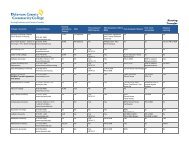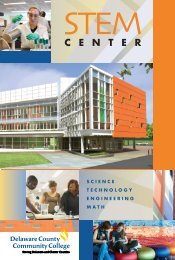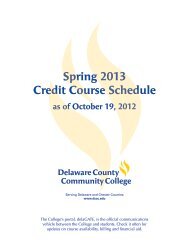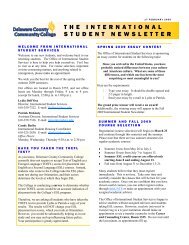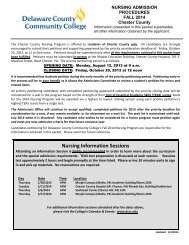2010 Catalog - Delaware County Community College
2010 Catalog - Delaware County Community College
2010 Catalog - Delaware County Community College
You also want an ePaper? Increase the reach of your titles
YUMPU automatically turns print PDFs into web optimized ePapers that Google loves.
COURSE DESCRIPTIONS 91<br />
and marine habitats. Emphasis will be placed upon<br />
regional conservation issues, biodiversity concepts, plant<br />
and animal interactions and adaptations, effects of human<br />
disturbance on native flora and fauna, and field research<br />
techniques. Students are expected to develop and apply<br />
skills in field research and in utilizing the scientific method.<br />
There are additional fees associated with this course that<br />
will vary depending upon the region being studied.<br />
Upon successful completion of this course, students<br />
should be able to:<br />
• Apply the scientific method to test hypotheses<br />
• Develop and apply skills used to identify, survey, and<br />
study plants and animals in a field setting<br />
• Describe local, regional, and global trends in biodiversity<br />
• Describe the processes and mechanisms that may affect<br />
biodiversity at local, regional, and global scales<br />
• Develop an appreciation of the ecological and economic<br />
value of biologically diverse habitats<br />
• Develop an appreciation of the value of diverse<br />
perspectives in a multicultural<br />
Prereq MAT 040, REA 050<br />
4 Credits 3 Weekly Lecture Hours<br />
2 Weekly Laboratory Hours<br />
BIO 117<br />
Human Anatomy<br />
The microscopic and macroscopic study of the human<br />
body. The laboratory includes a study of the gross and<br />
histologic structures of certain vertebrates, with emphasis<br />
on the cat. Dissection is required.<br />
Upon successful completion of this course, students<br />
should be able to:<br />
• Describe the anatomical parts of the body as a whole.<br />
• Discuss the structure of the body using the systematic<br />
approach: integumentary, skeletal, muscular, nervous,<br />
cardiovascular, respiratory, digestive, urinary,<br />
reproductive and endocrine systems.<br />
Prereq. MAT 040 and REA 050<br />
4 Credits 3 Weekly Lecture Hours<br />
2 Weekly Laboratory Hours<br />
BIO 118<br />
Human Physiology<br />
The study of the functions of the human body. Emphasis<br />
is placed on the interaction of the organ systems in the<br />
maintenance of body homeostasis. The lab will center<br />
around experiments on living vertebrates.<br />
Upon satisfactory completion of this course, students<br />
should be able to:<br />
• Apply the learned chemical concepts to the study<br />
of physiology.<br />
• Analyze the structural and functional aspects of a cell and<br />
its interactions with the environment.<br />
• Describe the ultrastructure of skeletal muscle and the<br />
mechanism of muscular contraction.<br />
• Analyze the mechanism responsible for the nerve<br />
impulse, the role of the autonomic nervous system in<br />
the maintenance of homeostasis and the perception<br />
of sensation.<br />
• Demonstrate an understanding of cardiovascular physiology.<br />
• Demonstrate an understanding of pulmonary physiology.<br />
• Analyze the physiological changes that occur in the<br />
gastrointestinal tract during the digestion of nutrients.<br />
• Analyze how the urinary organs function in the removal<br />
of cellular waste products from the blood and transport<br />
these wastes from the body.<br />
• Demonstrate an understanding of the role of fluids, the<br />
movement of ions and acid-base balance in maintaining<br />
homeostasis of the body.<br />
• Relate hormonal regulation to the physiology of the male<br />
and female reproductive organs.<br />
Prereq. BIO 117<br />
4 Credits 3 Weekly Lecture Hours<br />
2 Weekly Laboratory Hours<br />
BIO 150 Human Anatomy and<br />
Physiology I<br />
The first course in a two-semester sequence that covers<br />
the basic structure and function of the human body using a<br />
systems approach. Major topics covered include biological<br />
chemistry, cell biology, histology, integumentary system,<br />
skeletal system, muscular system, and nervous system.<br />
Laboratory work includes dissection, microscopy, models,<br />
and experimental demonstration of concepts covered in<br />
class. Dissection of preserved animal specimens is<br />
required. This course is designed primarily for students<br />
majoring in nursing or allied health fields. BIO 110<br />
(Introductory Biology I) is suggested, but not required,<br />
before enrolling in Human Anatomy & Physiology I.<br />
Upon successful completion of this course, students<br />
should be able to:<br />
• Demonstrate the correct usage of basic anatomical<br />
terminology<br />
• Describe how the body uses feedback systems to<br />
maintain homeostasis<br />
• Apply basic chemical concepts to the study of<br />
human physiology<br />
• Compare the major organic molecules found in the<br />
human body and describe their functions<br />
• Relate cell ultrastructure to the various functions<br />
performed by the cell<br />
• Compare the major tissues found in the human body<br />
and relate their structure and location to specific functions<br />
• Describe how the structure of the skin contributes to<br />
its functions<br />
• Describe the organization and function of the<br />
skeletal system<br />
• Categorize joints according to their structure and function<br />
• Analyze the ultrastructure of skeletal muscle and explain<br />
the mechanism of muscle contraction<br />
• Demonstrate an understanding of the physiology of<br />
nerve impulse generation and propagation<br />
• Analyze the structure and function of the spinal cord and<br />
spinal nerves<br />
• Analyze the structure and function of the brain and<br />
cranial nerves<br />
• Demonstrate an understanding of how the autonomic<br />
nervous system functions to maintain homeostasis<br />
• Relate the structure and location of the various sensory<br />
receptors to the perception of specific sensations<br />
• Demonstrate an ability to perform modern laboratory<br />
skills, including dissection and microscopy<br />
• Collect and analyze experimental data, formulate<br />
appropriate conclusions, and compile lab reports<br />
• Apply concepts learned in this course to one’s<br />
personal health<br />
Prereq. ENG 050, REA 050, MAT 060<br />
4 Credits 3 Weekly Lecture Hours<br />
2 Weekly Laboratory Hours<br />
BIO 151 Human Anatomy and<br />
Physiology II<br />
The second course in a two-semester sequence that<br />
covers the basic structure and function of the human body<br />
using a systems approach. Major topics covered include<br />
the endocrine, cardiovascular, lymphatic, respiratory,<br />
digestive, urinary, and reproductive systems along with<br />
immunity, metabolism, and fluid, electrolyte, and acid-base<br />
homeostasis. Laboratory work involves dissection,<br />
microscopy, models, and experimental demonstration of<br />
concepts covered during class. Dissection of preserved<br />
animal specimens is required. This course is designed<br />
primarily for students majoring in nursing and allied<br />
health fields.<br />
Upon successful completion of this course, students<br />
should be able to:<br />
• Evaluate the role of hormones in regulating body functions<br />
• Categorize the components of the blood and describe<br />
their functions<br />
• Demonstrate an understanding of cardiac anatomy<br />
and physiology<br />
• Relate the structure of the blood vessels to the<br />
hemodynamics of blood flow<br />
• Examine the structure and function of the lymphatic system<br />
• Analyze how the immune system functions to defend the<br />
body against disease<br />
• Demonstrate an understanding of respiratory anatomy<br />
and physiology<br />
• Demonstrate an understanding of digestive anatomy<br />
and physiology<br />
• Analyze how major metabolic pathways are used by<br />
the body<br />
• Examine the role of the urinary system in<br />
maintaining homeostasis<br />
• Assess the body's ability to maintain fluid, electrolyte,<br />
and acid-base homeostasis<br />
• Relate the structure of the male reproductive system to<br />
its function<br />
• Relate the structure of the female reproductive system to<br />
its function<br />
• Demonstrate an ability to perform modern laboratory<br />
skills, including dissection and microscopy<br />
• Collect and analyze experimental data, formulate<br />
appropriate conclusions, and compile lab reports<br />
• Apply concepts learned in this course to one’s<br />
personal health<br />
Prereq. BIO 150<br />
4 Credits 3 Weekly Lecture Hours<br />
2 Weekly Laboratory Hours<br />
BIO 200<br />
General Zoology<br />
A survey of the major invertebrate and vertebrate phyla<br />
including evolution within, biological contributions, basic<br />
structure, physiology and behavior of representatives of<br />
each subgroup.<br />
This course is designed for science majors who, upon<br />
successful completion, should be able to:<br />
• Prepare independently a research project in which the<br />
problem, background, procdure, apparatus and<br />
evaluation are thoroughly outlined.<br />
• Trace the development of life on the earth from the<br />
primitive atmosphere components through the initial<br />
heterotrophs.<br />
• Describe the taxa, behavior, biological contributions,<br />
characteristic systems and evolution in the unicellular<br />
invertebrates.<br />
• Describe the taxa, behavior, biological contributions,<br />
characteristic systems and evolutions in the higher<br />
metazoans excluding insects (Annelida, Mollusca and<br />
Arthropoda).<br />
• Describe the taxa, behavior, biological contributions,<br />
characteristic systems and evolution in the class Insecta.<br />
• In addition, explain why these are considered the most<br />
successful form of animal life.<br />
• Describe the characteristics, evolution and taxonomical<br />
subdivisions of the Chordates.<br />
• Explain the characteristics, taxonomy and organ systems<br />
of several vertebrate classes.<br />
• Describe the evolution within the vertebrates using fossil<br />
history, comparative behavior and anatomy.<br />
• Work independently in the laboratory by performing<br />
routine dissections and behavioral studies.<br />
• Develop a lab notebook.<br />
• Develop an extensive scientific vocabulary.<br />
Prereq. BIO 100 or BIO 111<br />
4 Credits 3 Weekly Lecture Hours<br />
2 Weekly Laboratory Hours<br />
BIO 210<br />
General Botany<br />
A study of the major plant divisions with an emphasis<br />
on basic structure, function, reproduction patterns, biological<br />
contributions, development and evolutionary relationships<br />
within each subgroup. Emphasis will be placed on the<br />
seed plants. Dissection is required. This course is<br />
designed for science majors.




